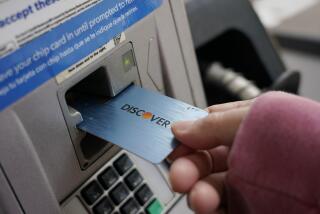A Shaky Economic House of Cards
How long can we continue to mortgage our future by going deeper and deeper into debt? The chickens are bound to come home to roost sooner or later. But how and when remains anyone’s guess.
This column reviews the continuing saga of growing public and private indebtedness in the U.S. economy and explores different ways in which we might eventually be forced to settle our accounts.
Probably the best measure of debt burden in the aggregate economy is the ratio of debt, in whatever sector, to total gross national product. As with households, debt looks very different in the economy depending on how much income is available to support it.
By this measure, until the 1980s, our two most serious episodes of indebtedness had occurred in the Depression and in World War II. In the Depression, GNP dropped so precipitously that pre-Depression levels of debt suddenly loomed like mountainous burdens; total private and public debt soared to more than twice GNP in 1932 and 1933.
And, by the end of World War II, government borrowing to finance the war effort also boosted our debt burden dramatically; total private and public debt reached almost 1 3/4 times GNP in 1945.
After the war, the shift to private accumulation in the “affluent society” led to a rapid decline in public debt burden, with only a partly compensating increase in private indebtedness. Whereas the ratio of total debt to GNP peaked at 1.72 in 1945, it dropped to 1.48 in 1948 and to 1.36 in 1951, rising only gradually through the mid-1960s, hitting 1.55 in 1967. The total debt burden grew at only 0.2% a year between 1948 and 1966.
After the mid-1960s, slower growth in incomes led to reduced growth in private borrowing--as both corporations and households tempered their cravings to avoid crippling interest and amortization burdens: Total private domestic debt burdens grew only half as rapidly from 1966 to 1979 as during the long, buoyant boom period from 1948 to 1966.
But during the 1980s everyone climbed back on the borrowing bandwagon. From 1979 to 1987, the average annual rate of growth of the total private and public debt burden reached 3.8% a year, compared to average of 0.4% a year from 1948 to 1979.
And nearly everyone shared in this binge, not solely the federal government. From 1979 to 1987, the government debt burden increased by 5% a year while the private domestic debt ratio grew by 3.7% a year. Within the private sector, among the most important groupings, private household debt burdens increased at a rate of 2.3% a year while the corporate debt burden rose at 3.1% a year.
Dangerous Debt Load
As a result, the level of indebtedness relative to GNP in the U.S. economy now sets a postwar record every year. The total debt burden hit 2.3 times GNP in 1987, compared to 0.82 in 1948. Corporate debt burdens had climbed to 0.42 of GNP in 1987, compared to 0.24 in 1948, and household relative indebtedness reached 0.63 in 1987, compared to 0.20 in 1948. Government debt is hardly the tallest pile of IOUs: Debt at all levels of government accounts for only about a quarter of the total debt in the economy, while private sector debt is more than three times as great.
These unprecedented levels of relative debt cannot continue to grow forever. Eventually, interest and amortization charges begin to cut into basic livelihoods, making it more and more difficult for households, corporations and the government to invest in our future. And such highly leveraged sectors become more and more vulnerable to economic recession, increasing the likelihood of bankruptcy and default.
But what gives first? How and when do we begin to hit the limits? As of late summer 1989, I can imagine three main scenarios for the days of reckoning.
A first and obvious scenario involves foreign creditors. For the time being, they seem content to buy more and more real and paper assets in the United States, helping finance our rising relative indebtedness. But there is no reason to assume that they will remain content to underwrite the U.S. economy forever. They could begin to pull out their money at a moment’s notice, flinching at the faintest sign of recession or financial fragility. Once their money flowed back overseas, nearly everyone in the U.S. economy would become vulnerable to a credit crunch or to soaring interest rates or both.
A second story line involves domestic collapse in one or another sector. How long can corporations continue to leverage themselves so heavily into debt, for example? (Interest payments in the non-financial corporate business sector reached 45% of before-tax profits in 1987, compared to only 3% in 1948 and 10% in 1966.) A rash of bankruptcies could follow quickly on the heels of recession, increasing the risks of serious financial collapse and of withdrawal of foreign money.
A third trail follows the path of steadier, less precipitous economic decline. As debt burdens grow, corporations may be forced to cut back on productive investment and/or to squeeze their employees even harder than in recent years. Similarly, as households’ debt burdens mount they may be forced to cut back drastically on such “luxuries” as college educations, condemning their children and the future economy to decades of stagnant growth in productive capacities and economic returns. As interest payments grow as a proportion of total income, financiers smile luxuriantly on the way to the bank, but the rest of the economy may sputter to a virtual halt.
None of these scenarios is attractive. Nor are there simple solutions. But it’s time for us to recognize that the debt disease has infected the entire economy, not merely the federal government. The problem runs much deeper than public debt. Rhetorical crusades against big-spending bureaucrats in Washington help fill the air with hot wind, but they do little else.
More to Read
Inside the business of entertainment
The Wide Shot brings you news, analysis and insights on everything from streaming wars to production — and what it all means for the future.
You may occasionally receive promotional content from the Los Angeles Times.










